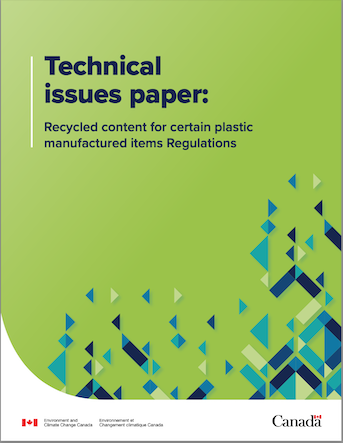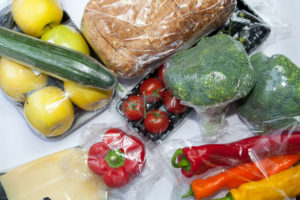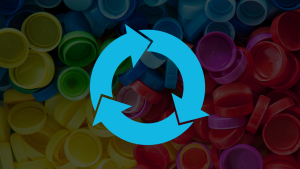- Plastics Marketplace
- Policy
- National
Responding to Minimum Recycled Content in Plastic Items
Related Resources
-

-

- Circular Economy
- Plastics Marketplace
- Case Studies
- ICI
- Reusable Packaging
- Best Practices
- National
Innovations in Circularity and Sustainability in Plastics
-

- Regulatory Tools
- Circular Economy
- Government
- Government Policy
- Labelling
- Recycling
- Policy
- Strategy and Policy
- Take Action
- National
Publication of a regulatory framework paper and technical paper to advance the plastics circular economy
Circular Innovation Council
Canadians and stakeholders were invited to comment on the technical issues paper, which presents considerations and options for key elements of the development of the proposed regulations.
Circular Innovation Council—along with Saskatchewan Waste Reduction Council, Recycling Council of Alberta, and Recycling Council of British Colombia—submitted a joint response.
Canadians and stakeholders were invited to comment on the technical issues paper, which presents considerations and options for key elements of the development of the proposed regulations.
Circular Innovation Council—along with Saskatchewan Waste Reduction Council, Recycling Council of Alberta, and Recycling Council of British Colombia—submitted a joint response.
Technical Issues Paper Highlights
- Goal of minimum recycled content requirements would be to strengthen the market demand for recycled plastics. This creates market pressures for increased collection, sorting, and recycling of plastic waste; and create incentives for investments in supportive infrastructure and in innovation, such as in improved product design for recycling.
- Government of Canada will require plastic packaging in Canada to contain at least 50% recycled content by 2030. This objective is supported by the Canadian Council of Ministers of the Environment, which endorsed a 50% recycled content requirement in plastic products, where applicable, by 2030 as part of Phase 1 of the Canada-wide Action Plan on Zero Plastic Waste.
- Regulations would require applicable plastic manufactured items to contain minimum prescribed amounts of recycled content. Regulations could apply to any person or business that manufactures, imports, or sells the items in Canada.
- Regulations would not replace other existing or future requirements, which would continue to apply to certain types of plastics, plastic products, and packaging.
- Government of Canada intends to establish recycled content requirements on the basis of product application (e.g., beverages) and format (e.g., rigid containers).
- Target packaging in the initial version of the proposed Regulations: bottles, rigid, flexible, and foam containers, film (e.g., shrink wrap), and others. Durable items like waste bins are being considered for the proposed recycled content requirements.
- Excluding primary (direct contact) food packaging from Regulations at this time, with the exception of beverage containers, with an intention to develop instruments and approaches that will increase recycled content in these application that could include future regulation.
- Options under consideration for defining recycled content for the purposes of the Regulations include:
-
- Post-consumer recycled content only (e.g., pre-consumer content would not be permitted to meet requirements).
- Post-consumer and pre-consumer recycled content (e.g., either category would be permitted to meet requirements).
- Post-consumer and pre-consumer recycled content with a maximum limit to the amount of pre-consumer content that would be permitted to meet requirements.
- Considering options for allowing outputs from chemical recycling technologies to meet the recycled content requirements in the proposed Regulations, and seeking feedback and evidence to support whether certain technologies should be within scope or not.
- Requirement for measurement and reporting of recycled content in plastic packaging, including annual reporting requirements.
- Setting minimum requirements for verification of reported recycled content that may be met through certification by accredited standards development organizations or other third parties.
- The proposed regulations are intended to be published as early as the end of 2022.
Joint Response Highlights
- PCR content standards are critical to the success of all the other plastic waste reduction policy directives as they will increase national recycling rates and support provincial extended producer responsibility initiatives.
- Regulation should be scoped to include products and packaging sectors that have additional considerations and challenges, such as food-grade packaging and health-related products.
- Regulation should be scoped broadly and allow for a phased-in approach to bring certain product categories under force when investments take effect, and market conditions and other regulatory requirements can be managed. Exemptions should be limited and considered on a case-by-case basis and justified by the sector/obligated party.
- The Government of Canada should examine purchasing criteria for all of its plastics goods to require high levels of PCR content. These criteria should be made part of the conditions of government stimulus to all public and private partners and shared with other levels of government .
- It is important the Regulation embrace and incent reuse as part of a policy recognition of the environmental preference of reuse over recycling as represented in the waste hierarchy. We recommend that plastic reusable products and packaging be mandated as other one-way items; be required to meet recycled content thresholds in their initial manufacturing; and be provided a one-for-one credit (by weight) toward future requirements when reused.
- Given the current low recycling rates and limited use of recycled content, any new source of plastics discards is critical to shift markets and meet stated climate and zero plastic waste goals for 2030. Both pre-consumer and post-consumer recycled content are legitimate sources that should be included, however, given its presence in the disposal stream, post-consumer materials should be preferred.
- As the chemical recycling industry continues to evolve, we propose that government continues to undertake research and, in particular, monitor and report the data on known projects and facilities, to gauge whether any of these processes can deliver plastic-to-plastic recycling and to determine the level and type of emissions and yields of each process.
- Oversight of compliance and verification is critical to minimizing fraudulent or inaccurate claims, and safeguarding market fairness and a level playing field for obligated parties. As such, the method to measure, report, and verify is of utmost importance.
- Absent from the Technical Issues Paper is any information on how obligated parties will be required to report and to whom; transparency of compliance to the public; oversight and compliance protocols, including roles and responsibilities of the federal government and applicable departments; and compliance mechanisms, fines, penalties, and remedies.
- Reporting and tracking compliance underpin success of the Regulation. Given the importance of the plastic waste and carbon reduction goals and objectives, we suggest that bi-annual reporting be required of all obligated parties. A frequent, yet reasonable, timeframe allows government to better understand and take stock of market effects, as well as direction of the Regulation.
- As the industry continues to evolve, we propose that government continues to undertake research and, in particular, monitor and report the data on known projects and facilities, to confirm that recycled content inputs sourced from chemical recycling processes can be verified.
- Obligated parties should be required to report claims and compliance efforts through the newly established national reporting registry created and operated by Environment and Climate Change Canada.




